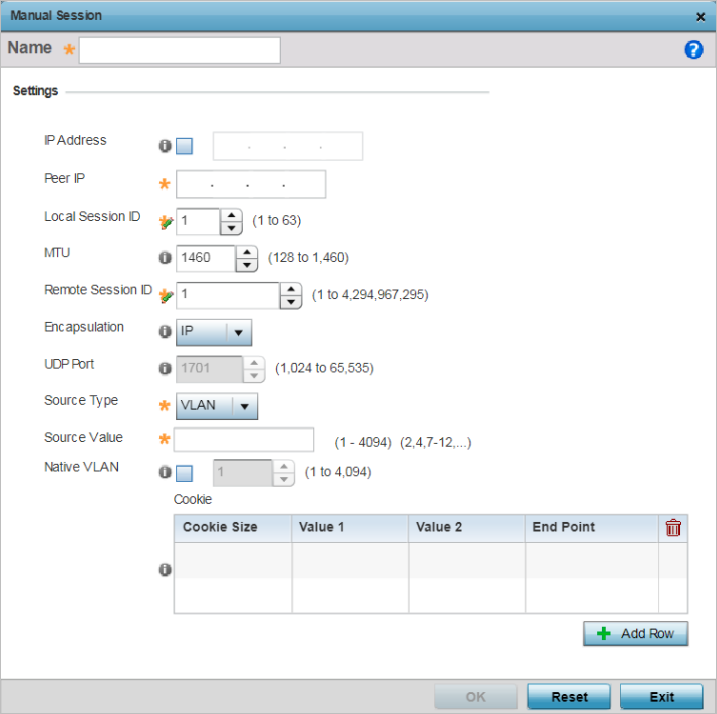Adding and Editing Manual Session
About this task
You can add a new L2TPv3 manual session configuration or edit an existing configuration.
Procedure
-
Click Add to create a
new L2TPv3 manual session. If creating a new configuration, assign it a 31
character maximum Name.
After a successful tunnel connection and establishment, the session is created. Each session name represents a single data stream.
-
To override the profile's L2TPv3
manual session configuration, select the L2TPv3 session from those listed on the
screen and click Edit.
The L2TPv3 manual session configuration screen displays.
 L2TPv3 - Manual Session Configuration Screen
L2TPv3 - Manual Session Configuration Screen
-
Set or override the following
session parameters:
IP Address
Specify the IP address used to be as tunnel source IP address. If not specified, the tunnel source IP address is selected automatically based on the tunnel peer IP address. This address is applicable only for initiating the tunnel. When responding to incoming tunnel create requests, it would use the IP address on which it had received the tunnel create request.
Peer IP
Set the IP address of an L2TP tunnel destination peer. This is the peer allowed to establish the tunnel.
Local Session ID
Set the numeric identifier for the tunnel session. This is the pseudowire ID for the session. This pseudowire ID is sent in a session establishment message to the L2TP peer.
MTU
Define the session‘s MTU (maximum transmission unit) as the size (in bytes) of the largest protocol data unit the layer can pass between tunnel peers in this session. A larger MTU means processing fewer packets for the same amount of data.
Remote Session ID
Use the spinner control to set the remote session ID passed in the establishment of the tunnel and set a unique identifier for this tunnel session. Assign an ID from 1 - 4,294,967,295.
Encapsulation
Select either IP or UDP as the peer encapsulation protocol. The default setting is IP. UDP uses a simple transmission model without implicit handshakes.
UDP Port
If UDP encapsulation is selected, use the spinner control to define the UDP encapsulation port. This is the port where the L2TP service is running.
Source Type
Select a VLAN as the virtual interface source type.
Source Value
Define the Source Value range (1 - 4,094) to include in the tunnel. Tunnel session data includes VLAN tagged frames.
Native VLAN
Select this option to define the native VLAN that‘s not tagged.
-
Select the + Add Row button, in the
Cookie table, to set the following:
Cookie Size
Set the size of the cookie field within each L2TP data packet. Options include 0, 4 and 8. The default setting is 0.
Value 1
Set the cookie value first word.
Value 2
Set the cookie value second word.
End Point
Define whether the tunnel end point is local or remote.
-
Click OK to save the
changes to the session configuration.
Click Reset to revert to the last saved configuration.


